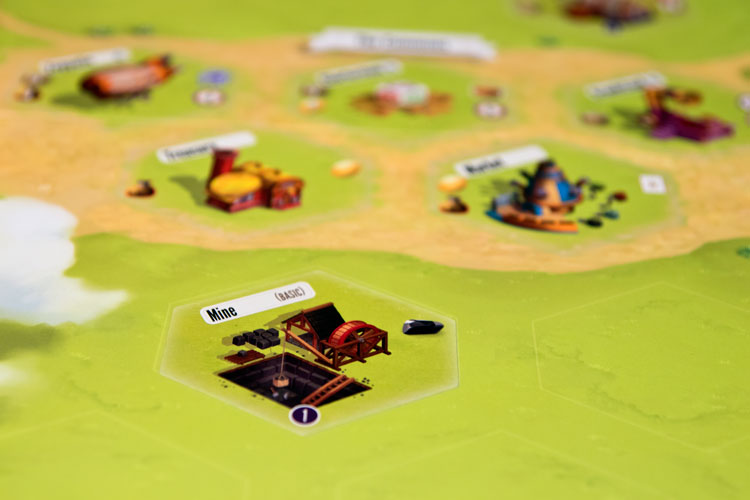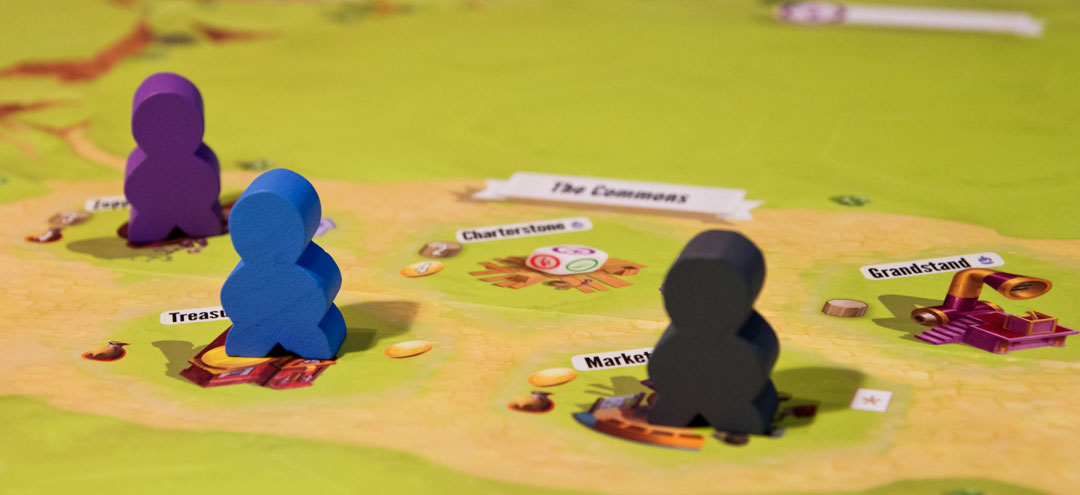Note: As Charterstone is a legacy style game, we’ve labeled any potential spoilers to avoid having the surprises ruined for you.
 The legacy genre was started with Rob Daviau and his take on the classic game Risk. Risk: Legacy brought a breath of fresh air to tabletop gaming with his almost unheard of need to destroy and write on game components.
The legacy genre was started with Rob Daviau and his take on the classic game Risk. Risk: Legacy brought a breath of fresh air to tabletop gaming with his almost unheard of need to destroy and write on game components.
Recently, more game designers have decided to embrace the legacy model. Some, like Pandemic: Legacy, surpassed everyone’s wildest dreams, while others just didn’t work out (Seafall). Enter Chartersone, designer Jamey Stegmaier’s (Scythe, Viticulture) take on a city building, legacy style game. It’s a great concept, but is it fun? Time to find out.
Gameplay Overview:
As this is a legacy style game, I’m only going to give you a brief overview of the rules for the first game (You can download a PDF here if you want more info). Any additional rules will be up to you to discover. The rulebook has space for 29 rule boxes, but you only begin with about half of those in play.
Charterstone is a worker placement game where the goal is to earn the most points each game, with a campaign winner being declared after the 12th game. Each player takes charge of one 6-plot charter in a shared village.

On a player’s turn, they have the option of either placing one of their workers, or retrieving all their workers. The game begins with only a handful of spots use. In the center of the board is the “Commons”. These five, permanent spots allow players to gain money or advancement cards, score an objective card, construct a building in their charter, or open a crate.
Each charter (6 in total) also starts with one basic resource building. Any player can go to any charter to use a building. New buildings are only constructed in a player’s own charter. After building it, the empty card is kept by the player as a crate. A player can open that crate on a later turn by using the Charterstone building in The Commons. This will have player diving into the “Index” and pulling out one or more cards, some of which will add new rules to the game.
Players continue taking turns until the progress track reaches the end space. The progress marker is moved anytime a player opens a crate, constructs a building, or scores an advancement. It also moves automatically at the start of a players turn if they’ve spent all 12 of their influence markers (certain actions require spending influence as part of the cost). The player with the most victory points at the end of the game wins.

Game Experience:
So let’s start with the things I can freely talk about. At the beginning, Charterstone is the most basic of worker placement games. Go to a building, pay X, collect Y. To be honest, the first few games of Charterstone were a bit underwhelming. The majority of our time was spent simply trying to build as many buildings as possible and opening crates. (A building card often contains a crate which can be opened once the building has been built.) I will say that we really enjoyed opening crates, as I was always curious what the new cards would bring.

While opening lots of crates early on does provide a steady dose of excitement, it also can throw a barrage of rules at the players. More than once we had to get clarification on new rule, and I think that was simply because there were so many new things hitting us in rapid fire. This was also much less of an issue as we hit the later games.
My main enjoyment in the game really came from optimizing my charter. Each player has 6 spaces they can use, and you really want them to be as efficient as possible (see the spoiler section below for why). I loved finding just the right building that fits perfectly with others I’ve placed to create wicked combos. Go to this building first, then hop to this one second, and then finish here to score lots of points.
Charterstone is not only a legacy game, but a campaign game, which means you should really play with the same people throughout the game. The rules do include options for add/dropping players mid-campaign, which we tested and it works fine. Our games were mainly 2 player experiences and overall we had no issues. The only thing I wish was stronger was dealing with the inactive charters.
There are rules for growing the inactive charters, yet they don’t have anywhere near the customization of a player’s own charter. I found myself wishing that instead of having 6 separate charters in a 2p game, I’d rather have more space for my own. There were lots of buildings I wanted to use and just couldn’t fit in my own charter. The other issue is that the buildings in the inactive charters can be somewhat random, many we never even used (more on that below).

*******************
SPOILERS BELOW: The rest of the Game Experience is going to dive briefly into unlockables. If you don’t want to know about any of those, skip to the Final Thoughts.
*******************
Each game after the first adds something called a guidepost card. These create an objective and special rules for the next game. Whoever achieves the guidepost gets to scratch off a box and choose a direction for the town (Happy King or Angry King). I thought Charterstone was strongest when using these cards. It helped prevent things from getting overly repetitive from game to game. I found myself tailoring my strategies to try to be the person that won the guidepost, even if it mean scoring a sub-optimal amount of victory points.
Earlier I mentioned that it’s important to optimize your own charter. That’s because the game introduces 6 different minions, which are unique workers that can only be used in your own charter. Each of these will provide a bonus when placed, such as drawing a card, a free resource, or even extra victory points. It’s not uncommon in a game to have 4 or more minions in addition to your regular two workers. And as they can only be placed in your home charter, you absolutely have to have buildings there that you will want to use early and often. I was a big fan of the minions and liked how they not only provided bonuses, but also encouraged to make sure your charter is the best in the city.
Jumping back to the inactive charters for a minute, the other issue with these is that there is no way to replace the buildings that were constructed there. As we mentioned earlier, some we never used. But another problem comes with the fact that some resources end up being fairly useless. Our board is completely filled, and not a single building requires coal in it’s cost. One player even had a card that gave them a bonus for using a coal building, effectively making that card useless.
We would have liked the option to replace buildings in inactive charters with ones we’d actually want to use. This is especially true once you have your own charter in a place where you don’t want to change much. I ended up keeping one building my charter the “dumping grounds”, where I would continually replace that one building with others, just to keep getting crates to open.
*******************
END SPOILERS
*******************
Final Thoughts:

As with any legacy game built off a new IP, Charterstone had a great potential to be a flop. The system was untested and players needed to learn both it, and deal with new rules constantly being thrown at them. Yet Stonemaier was able to pull it off. I will say that I think the later games of Charterstone are MUCH more interesting than the early ones. Things you unlock and build are going to vastly improve your options in the game, and thus, your enjoyment.
As is expected with a Stonemaier Games product, the artwork and components in Charterstone are all excellent. The photos of the resources in this review are from a add-on components produced by and were provided to us for the review. We both loved playing with them and I honestly would have probably bought them anyway. But I’m also a bit of a component addict. If you are fine with wooden cubes in games, then the included tokens will work just fine for you.
While Chartertone does try to tell a story as the game progresses, we were never really that engaged with it. This isn’t going to be a deep, thematic experience. However, it is a solid worker placement game that will let you build things as your like. For players who love to be able to customize their strategies, and also watch things grow, Charterstone will be hit.
Final Score: 4 Stars – A unique and well made worker placement game that starts off slow, but picks up steam as the campaign progresses.
 Hits:
Hits:
• Unique idea for a worker placement game
• Excellent art and components
• Rules to add/drop players mid campaign
• Great ideas kept appearing
Misses:
• Wish for bigger charters at the lower player counts
• Early games are a little lack luster
• Early rules barrage can be a bit much






















